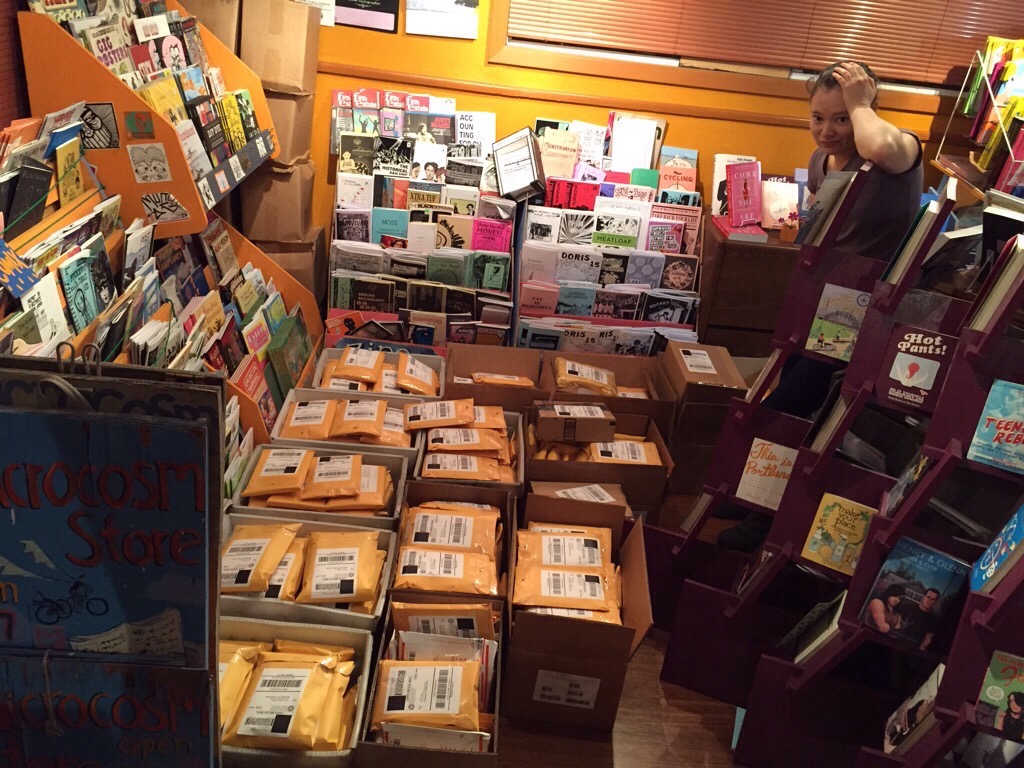Customers want to matter. But with giant online retailers like Amazon controlling consumer data, how do publishers identify and engage with their readers?
The answer lies in direct-to-consumer (DTC) sales. But this approach involves more than just building an online store and hoping customers will come. Publishers need a DTC sales strategy that includes choosing the right tech assets, attracting traffic to their online store, and engaging with customers in meaningful ways that keep them coming back.
Why Direct?
For Joe Biel, CEO of Microcosm Publishing, developing a DTC sales strategy was a matter of necessity. “In 1996, we were turned away from many retailers,” Biel says. “So, we focused on DTC from the start.” This focus has served Biel’s company well. “We have sold millions of dollars through DTC,” Biel says. “For many titles, we have sold 3,000 to 10,000 copies via DTC, in some cases exceeding retailer orders.”
Biel says that an online strategy can be especially helpful for moving backlist titles. “We want to direct people to their local retailers, first and foremost,” Biel says. “But for books that aren’t stocked there any longer, we want to provide them with a personalized experience of mail order where they receive promotional stickers, free copies of overstock, and a poster comic that tells our story.”
At Rattling Good Yarns Press, managing publisher Ian Henzel attributes over 20% of the company’s sales to DTC strategies. Henzel says the company’s focus has been clear from the beginning—they are an LGBTQ+ owned and operated press for exclusively LGBTQ+ authors and titles—but it took a year or so for them to start doing DTC mailings. “We see a bump in sales with each email blast we do,” he says. “Our No. 1 goal is to increase the size of our direct-to-consumer mailing list.”

Nathan Bond, president of Fair Share Publishing, recently launched his company with 100% of his sales revenue coming from online DTC sales. “While we are expanding to sell to libraries and schools, we anticipate that 90% of our sales will continue to come from DTC channels, ensuring a direct and personal connection with our readers,” he says. “This also enables us to pay our authors and illustrators three to four times the industry standard royalty rate.”
Make It Special
Successful DTC strategies identify and incorporate online tools for ensuring a positive customer experience. That includes offering unique products and experiences customers can’t get through platforms like Amazon.
“We found that it was impossible to really reach readers who buy from retailers, so we started offering perks for buying DTC,” says Unsolicited Press publisher Summer Stewart. Her company developed “a pretty rad online DTC strategy” that now accounts for half of its sales.
One aspect of Unsolicited’s multipronged approach involves offering customers a free e-book of the same title when they purchase a print edition. That way, Stewart says, readers always have access to the book. The company also offers free shipping to Substack subscribers who buy through their site. In addition, customers who purchase direct are invited to attend live question-and-answer sessions with Unsolicited authors.
For its online customers, Unsolicited is also marketing a book box subscription with a limited number of subscriptions available. “The boxes are red. The book covers are red. It’s beautiful,” Stewart says. “We are encouraging readers to do unboxings in addition to providing random merchandise with each box.”
At a store hosted on Squarespace’s e-commerce platform, Carrara Media’s author-publisher Ryan ZumMallen offers customers preorders with early shipping, autographed copies, and free prints or postcards included with orders. “Especially successful was our unique, store-only, limited edition cover with [a] higher quality feel and only 250 made,” he says. With his DTC strategy, ZumMallen says he enjoys “huge profit margins” compared with selling through other retailers.
While many publishers use Shopify for their online stores, Henzel favors WooCommerce. Funnel management software allows him to enhance the customer experience by, for instance, suggesting similar titles that might be of interest. He uses tinyurl to generate trackable links for evaluating the click-to-conversion rate.
For email integrations, Henzel relies on MailPoet. Jet CRM refines the strategy by facilitating customer segmentation. “For example, when targeting a title, we will exclude consumers who have already bought the book,” he says. “The halo effect of doing this is to reduce the number of unsubscribes.”

At Fair Share Publishing, readers can use QR codes embedded in print editions to engage with online content such as games, audio, and educational back matter. “For some books, these QR codes provide access to continuously updated content, keeping the book fresh even after multiple reads,” Bond says. “The QR codes also give us valuable data on how they’re being used, which helps us see how effective they are as engagement tools.”
Bond also uses the online tool FlippingBook to enhance the customer’s experience. “I was on the lookout for a versatile way to share book previews because, as a parent, I was always frustrated by the lack of inside images when buying books for my daughter,” he says. In addition to facilitating these previews, FlippingBook offers ways to embed author videos, polls, and forms. Beyond its shopping site, Fair Share uses FlippingBook in its newsletters, featuring unpublished artwork, microstories, and new ideas from emerging artists. “It creates a truly immersive experience,” Bond says.
The service also tracks engagement data. So far, the feedback from users has been overwhelmingly positive. “People love the way FlippingBook previews our books in email campaigns while keeping the content protected,” he says. “As we gather more data, we plan to refine our use of FlippingBook and explore additional tech innovations to enhance customer engagement even further.”
To optimize the DTC experience at Microcosm, Biel built a custom software platform, WorkingLit.com. “Most of our customer feedback is that our website is fun,” Biel says. Also in the works is a custom website front end for every logged-in customer, based on their purchasing history.
Some publishers fulfill their own online orders. Others rely on services like BookFunnel for digital fulfillment. For print books, Lulu is one print-on-demand (POD) option that includes order fulfillment.
“The DTC segment of Lulu’s business is growing fast,” says public relations manager Sarah Gilbert. Lulu integrates with shopping platforms such as Shopify, WooCommerce, and Wix. Publishers who want to sell direct from their own websites can tap Lulu’s API feature. Lulu also allows for custom shipping inserts, so shipments appear to have come directly from the publisher.
“Readers want to support their favorite authors, and when they understand that buying direct results in more revenue for the author-publisher, they’ll always buy direct,” Gilbert says. And she notes that for publishers, having customer data is “the most valuable thing to be able to scale.”
Multiple Ways to Drive Traffic
No matter how seamless the shopping experience is, a DTC strategy must also include tactics for steering customers to the online store. “Driving traffic to our DTC site involves a multifaceted approach,” Bond says. For his company, that approach includes social media, press releases, email campaigns, and authentic content creation to boost SEO.
To develop influencer partnerships, Bond relies on the brand marketing team at Branch & Bramble. He has hired writers to produce industry-relevant content, and a series of podcast interviews with Fair Share’s creators is in the works.
“It’s essential to appear where people’s attention is, as we operate in an attention economy,” Bond says. “Our strategy ensures that we are consistently engaging with our audience through multiple touch points.”
Biel also uses multiple tactics to market Microcosm’s DTC experience. “Everything has to lead back to our website,” Biel says. “We pass out 20,000 poster catalogs per year with our website on it. We are in the news every week. We appear at dozens of events per year. We have built subscription models for various series so that the funnel always leads customers back to us, especially if they purchased something from Amazon.”

At Rambling Good Yarns, Henzel relies heavily on social media to drive traffic to the company’s store. “We promote our books daily through all social media channels except for X,” he says. “We also have a YouTube channel.” For content, the company produces a unique book trailer for every book they publish. They also post “Why We Published” videos. “These are cozy fireside chats where we explain why we chose to publish a title and why we think readers will love it,” Hentzel says.
To expand his company’s reach, Henzel is pilot testing automated advertising through Shimmr AI. He is also planning to add a blog component to the company’s website, with posts promoted via social media. “Blog articles will give us another reason to reach out to our mailing list,” he says. “We will have a specific pop-up customized to the blog page and content to encourage readers to subscribe.”
Keep Them Coming Back
Good DTC strategies go beyond the initial sale by incorporating incentives and engagement opportunities that encourage customers to return again and again. “When customers purchase a book from us, they receive the e-book for free, access to various audio versions, downloadable activity sheets, and coloring pages,” Bond says. Customers who sign up for the newsletter also get a 10% discount on purchases.
In addition, Fair Share hosts a virtual gallery where young readers can submit their artwork, promoting a sense of community. “These offers and interactive content are seamlessly integrated into our sales funnel, enhancing the overall customer experience and encouraging repeat engagement,” Bond says. At Unsolicited Press, Stewart entices customers to return with invitations to online readings and talks with authors. She also incentivizes with free merchandise, e-books, and audiobooks.
Biel points to the benefits of a regular newsletter for reminding customers why they chose to buy direct. “We offer coupons in our newsletters for our own website, and we offer specialized, discounted e-books if someone buys the print book of the same title,” Biel says.

Whether the incentives are clubs, special editions, early releases, author notes, or merchandise, Gilbert says it all boils down to asking customers what they want and then delivering it. “If they want a special edition with an alternate ending, go for it,” she says. “These are the fun things publishers can do with a direct sales approach. It’s all about the experience for the reader, and direct sales is a great way to build relationships.”
An Engaging Journey
Building a DTC strategy involves many of the same tactics that lead to success in business overall. To succeed with their own online stores, publishers need to identify their purpose, implement appropriate tech tools, and learn by example.
“Consider your press’ value proposition first and foremost,” Biel says. “Then build the DTC strategy around that proposition. If it’s price, you should be the cheapest. If [your customers] want to support you, show humanity. If it’s value, give freebies.”
Bond urges publishers to identify the problem they want to solve and the experience they want to create. “Then look for technology that can help you achieve that goal,” he says. “There’s a lot of tech out there not specifically designed for publishing that can be incredibly effective. Stay innovative and open-minded, and use technology to create a seamless and engaging journey for your customers.”
ZumMallen encourages publishers to search broadly for fresh ways of engaging customers with direct sales. “Look for examples from other industries and brands your target buyers like outside of the publishing world,” he says. “How do they attract people? There’s no reason you can’t use those same strategies for books.”
There may be missteps along the way, but without a DTC strategy, publishers risk getting stuck in a retail rut that throttles their long-term profit potential. Informed by his background in software product management, Henzel advises publishers to be willing to try new tactics as long as they have methods in place to track results. “My further advice is to fail fast,” he says. “Try new things, but if they fail, move on as quickly as possible. Every failure brings you one step closer to something that works.”
Deb Vanasse is the author of dozens of published books. She works as a freelance editor and is an author-publisher at Vanessa Lind Books.